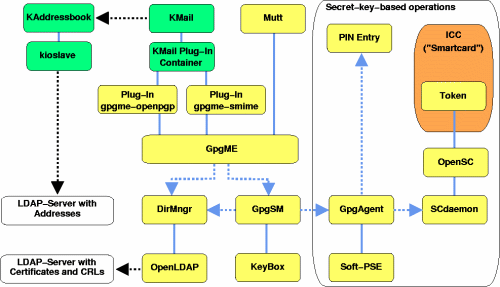Project Ägypten: Technology
Home | Technology | Who | Schedule | Development | Public Relations | Glossary
This page provides an overview. The CVS repository contains technical details. Note that some of parts of this page have not been translated from German.

 Strong connection: with two-way
communication accomplished by direct linking or KDE plug-in methods
Strong connection: with two-way
communication accomplished by direct linking or KDE plug-in methods
 Client/Server communication: Client (A)
requests a service from Service provider (B). This is either
accomplished by using Unix Domain sockets, shared memory or hardware
connection.
Client/Server communication: Client (A)
requests a service from Service provider (B). This is either
accomplished by using Unix Domain sockets, shared memory or hardware
connection.
 KDE-dependent module
KDE-dependent module
Plug-In Container/Plug-Ins de
Die Plug-Ins für S/MIME und OpenPGP umfassen jeweils eine vereinfachte API zur Durchführung der gewünschten Krypto-Funktionen. Für die Aufrufe der Basis-API (mit GpgME bereitgestellt) werden die in den Plug-Ins gehaltenen Konfigurationseinstellungen berücksichtigt (z.B. sende komplette Zertifikatskette: ja/nein). Das jeweilige Mail-Programm stellt alle Benutzerdialoge für diese Einstellungen zur Verfügung und läd/speichert sie aus den für das jeweilige Mail-Programm spezifischen Konfigurationsdateien.
Der Plug-In Container stellt die API der Plug-Ins innerhalb des Mail-Programms zur Verfügung. Er ist spezifische für jedes Programm und umfasst die Benutzerdialoge für Konfiguration.
GpgSM
This module is responsible for encryption and key-management. It has been designed and implemented according to GnuPG and offers among other features a database for certificates. The format of this database can also be used by GnuPG, so all public keys can be saved in a single file.
Private keys are not handled by GpgSM; it delegates the operations of signing and decryption to the GpgAgent. When decrypting, this delegation only concerns the decryption of the Session-Key; the symmetric decryption however is done here. The module is capable of encrypting data streams of arbitrary length. It offers a command line interface widely corresponding to the interface of GnuPG.
GpgSM is also responsible for the generation of keys and related messages. The key generation itself will be delegated as usual to the GpgAgent, enabling it to save the private key directly in it's PSE.
Apart from the mandatory algorithms, AES will be also implemented. Because it is not yet mentioned in the specification, it's use will be made available by a certain option in the configuration.
GpgAgent
This module takes over multiple tasks:
- It takes over all cryptographic operations requiering a private key.
- It manages both the Soft-PSEs and the Token PSE.
- It saves the fingerprint of the root certificate.
- It delegates operations to a krypto token, using the standards PKCS11, PKCS12 and PKCS15.
- Optionally, it is capable of assuring the integrity of the system (i.e. it's modules and certain keys). To assure this, it uses a MAC, whose key is derived from a PIN.
- It offers functionality for both import and export of the private keys.
- It generates new key-pairs.
For querying the PIN, the GpgAgent uses the PIN Entry-module. Special measures to protect the sensitive information are implemented here (e.g. to protect information from being swapped to the harddrive).
The design of this modules interface enables the module to be completely implemented on a seperate hardware module.
DirMngr
This module controls all directory accesses and performs search operations. To accomplish this, it also uses OpenLDAP directly. Certificate Revocation Lists (CRLs) are kept in a local cache by this module and their validity is directly checked here. It is linked against the hereby required libraries.
PIN Entry
This is a very simple module, it only opens a modal dialog and asks for the PIN. Using a special protocol, it cooperates directly with the GpgAgent. This functionality is not built into the GpgAgent directly to avoid linking against the complex GUI code. Furthermore, the module can be adopted to existing graphical user interfaces easily.
Within the project the PIN Entry will be implemented as a qt-, gtk- and text-version. Possibly an even simpler version using the basic grapical user interface (X11) will be added in the future This would simplify code-validation.
Funktionsweise und Datenfluß de
Schlüsselerzeugung
Neue Schlüssel werden über das Konfigurationsmodul von KMail erzeugt, welches hierzu GpgSM mit der Schlüsselerzeugung beauftragt. GpgSM gibt dies an GpgAgent weiter, der die sicherheitskritischen Operationen durchführt und den privaten Schlüssel in der PSE abstellt. Über einen weiteren Dialog kann eine Zertifizierungsanfrage erstellt sowie weitere Schlüsselverwaltungsfunktionen durchgeführt werden.
Signieren
Die zu signierende Nachricht (bzw. das MIME-Objekt) wird zusammen mit der Identifikation des zur aktuellen Rolle gehörenden Zertifikats an GpgSM gegeben, welches die Signatur berechnet. Da zur Erzeugung der Signatur der private Schlüssel notwendig ist, wird die grundlegende Signaturoperation nicht direkt von GpgSM durchgeführt sondern an GpgAgent delegiert. Hierbei werden allerdings lediglich die absolut notwendigen Parameter sowie der Hash der Nachricht weitergegeben (optional kann auch der Hash von GpgAgent berechnet werden und die Nachricht durch einen speziellen Viewer angezeigt werden; dies ist aber nicht sinnvoll, solange GpgAgent nicht auf externer Hardware ausgeführt wird).
GpgAgent wird in seiner PSE nach dem privaten Key suchen, eine PIN von dem PIN-Entry Modul erfragen und dann die Signatur erzeugen. Der PKCS-1 Wert wird dann an GpgSM weitergegeben der dann die signierte Nachricht aufbaut.
Nach Rückgabe an das MUA-Plug-in wird dieses entscheiden, ob die Nachricht verschlüsselt werde soll und dies entsprechend dem oben geschilderten Verfahren durchführen. Soll es nicht verschlüsselt werden, so wird die signierte Nachricht direkt versendet, wobei je nach Konfiguration Zertifikate mitgesendet werden.
Signaturprüfung
Der MUA-Plug-in zerteilt die Nachricht in ihre Bestandteile und gibt den Plaintext sowie die Signatur zur Überprüfung an GpgSM weiter. Enthält die Nachricht auch ein Zertifikat, so wird dieses vorher an GpgSM gegeben, so daß es über das Zertifikat verfügen kann; ist kein Zertifikat vorhanden, so wird GpgSM den DirMngr beauftragen die entsprechenden Zertifikate zu besorgen. Hierzu wird der DirMngr auf das LDAP-Service-Modul zurückgreifen. Nach erfolgreicher Signaturprüfung wird GpgSM sich wiederum an den DirMngr wenden, um festzustellen, ob eines der verwendeten Zertifikate in einer CRL vorkommt; sollte dies der Fall sein, so wird dieser Status direkt im zu GpgSM gehörenden Zertifikatspeicher vermerkt, um so weitere Signatur-Verifikationen direkt scheitern zu lassen.
Der Signatur-Status sowie alle verfügbaren Metainformationen werden an das MUA-Plug-in zurückgegeben, welches den Status der Signatur entsprechend anzeigt.
Verschlüsselung
Das MUA Plug-in stellt anhand der Adressaten eine Liste von Zertifikaten zusammen. Hierbei bedient es sich sowohl der internen Datenbank von GpgSM als auch des DirMngr. Jedes ermittelte Zertifikat wird durch das PKI Modul gegen die CRLs getestet und nur die gültigen Zertifikate werden angezeigt. Dies erspart eine spätere Prüfung in GpgSM und eine damit verbundene Rückweisung.
Es wird dafür gesorgt, dass alle notwendigen Zertifikate in der durch GpgSM gepflegten Datenbank vorhanden sind. Die zu verschlüsselnde Nachricht (bzw. das Attachment) wird zusammen mit den internen Identifikationsnummern (fingerprints) der Zertifikate an GpgSM weitergegeben, welches dann die Verschlüsselung vornimmt und das verschlüsselte Objekt zurückgibt. Das neue Objekt wird nun wieder in einen MIME Kontext eingebunden und versendet.
Entschlüsselung
Ist eine empfangene Nachricht verschlüsselt, so wird diese an GpgSM weitergeleitet, die dann GpgAgent beauftragt den Session-Key zu entschlüsseln. GpgAgent bedient sich hierzu entweder den eigenen Funktionen und der Soft-PSE oder delegiert die Aufgabe an eine Smartcard.
(C) Intevation, Verbatim copying and distribution of this entire page is permitted in any medium, provided this notice is preserved.

